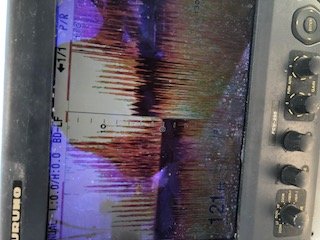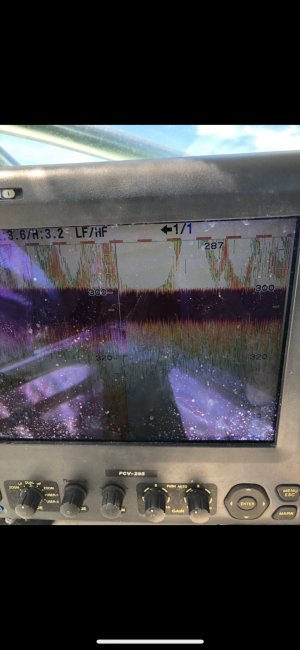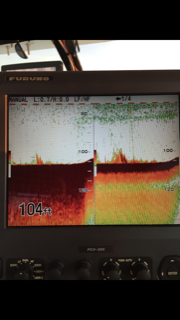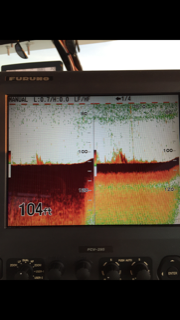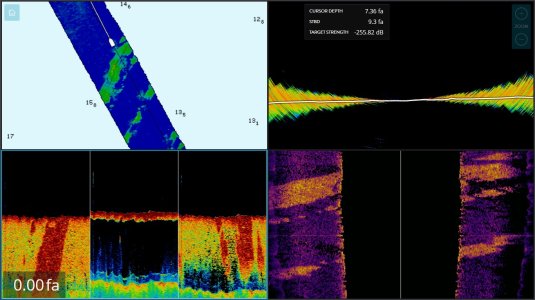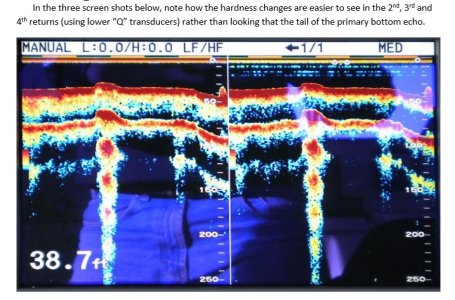You are using an out of date browser. It may not display this or other websites correctly.
You should upgrade or use an alternative browser.
You should upgrade or use an alternative browser.
295 Interferance
- Thread starter Seadog
- Start date
S
Snips
Guest
Seadog,
Let me understand you correctly. You are using the FCV-295 with two 200Khz transducers, one is the in hull R-199 and the other is a wet faced 82m. Which one is on the LF side?
Snips
Let me understand you correctly. You are using the FCV-295 with two 200Khz transducers, one is the in hull R-199 and the other is a wet faced 82m. Which one is on the LF side?
Snips
S
Snips
Guest
Seadog,
The current trend seems to be trying to use the primary echo on 200Khz for bottom hardness.
Personally I disagree in looking at hardness using this method.
Also something to know about the FCV-295 is that both sounder channels transmit at the time. This means if both channels are set at 200KHz they are receiving a combined bottom return.
Snips
The current trend seems to be trying to use the primary echo on 200Khz for bottom hardness.
Personally I disagree in looking at hardness using this method.
Also something to know about the FCV-295 is that both sounder channels transmit at the time. This means if both channels are set at 200KHz they are receiving a combined bottom return.
Snips
S
Snips
Guest
Seadog,
The way you have the sounder set up it is hard for me to tell what those lines are. 90% of the time true interference will have some sort of a pattern to it. The best way to see it is to double the sounders range, so if you are fishing in 400ft of water set the range to 0-800ft and then turn up the gain control. Can you post a screen shot like that?
Snips
The way you have the sounder set up it is hard for me to tell what those lines are. 90% of the time true interference will have some sort of a pattern to it. The best way to see it is to double the sounders range, so if you are fishing in 400ft of water set the range to 0-800ft and then turn up the gain control. Can you post a screen shot like that?
Snips
S
Snips
Guest
Seadog,
I agree, much clearer.
But lets take this a little further as it will help everybody in the art of ground truthing.
Besides being clearer, what else can you tell me about your friends 295 screen shot?
Snips
I agree, much clearer.
But lets take this a little further as it will help everybody in the art of ground truthing.
Besides being clearer, what else can you tell me about your friends 295 screen shot?
Snips
Snips
He is running a 12m on his 295. You can clearly see where it comes from hard to soft bottom. He runs it on range 60ft and very slow scroll. I have tried his sittings on both of my transducers but not even close to the same results. If I could get the vertical lines out of mine it would be closer to his. The second echo is really useless in the GOM as we are fishing hard flat bottom. You really can not mark grouper unless they are out feeding so we just fish bottom. Appreciate any help.
He is running a 12m on his 295. You can clearly see where it comes from hard to soft bottom. He runs it on range 60ft and very slow scroll. I have tried his sittings on both of my transducers but not even close to the same results. If I could get the vertical lines out of mine it would be closer to his. The second echo is really useless in the GOM as we are fishing hard flat bottom. You really can not mark grouper unless they are out feeding so we just fish bottom. Appreciate any help.
S
Snips
Guest
Seadog,
So if you are using the same machine and exacting the same settings the only variable would be the 82m vs the 12m, correct? The beam angle of the 82m is 5.4 degrees at the 3db point and 7.4 at 6db compared the 8.5/12 degrees for the 12m, roughly 60% greater. This follows the second characteristic of ground truthing in that wider beam angles tend to produce better bottom tails.
Below is a nice example albeit not apple to apples comparison because it is from a WASSP system. In the triple beam view (lower left) the center beam is looking +/- 20 and the two side beams are 20 to 60 degrees. You can see as we ran over that hard area that it was bearly visible in the center beam but clearly stood out in the side beams.
I know all this doesn't address those lines you are seeing and I would still like to see if they are still there using a deeper range scale.
Snips
So if you are using the same machine and exacting the same settings the only variable would be the 82m vs the 12m, correct? The beam angle of the 82m is 5.4 degrees at the 3db point and 7.4 at 6db compared the 8.5/12 degrees for the 12m, roughly 60% greater. This follows the second characteristic of ground truthing in that wider beam angles tend to produce better bottom tails.
Below is a nice example albeit not apple to apples comparison because it is from a WASSP system. In the triple beam view (lower left) the center beam is looking +/- 20 and the two side beams are 20 to 60 degrees. You can see as we ran over that hard area that it was bearly visible in the center beam but clearly stood out in the side beams.
I know all this doesn't address those lines you are seeing and I would still like to see if they are still there using a deeper range scale.
Snips
Attachments
S
Snips
Guest
Seadog,
Three thing's to note about the R-199.
1st it's an in-hull, which depending on the thickness of the hull has a performance loss of around 20%.
2nd is the beam width, forward/aft is more important than port/stbd.
3rd is that the R-199 has a "Q" factor of 3 at 50Khz and 6 at 200Khz. The "Q" is how much a transducer will ring after transmission. The more it ring's the better job it does in displaying different bottom types.
It will be a good test using your CA200B-5S as it has very similar characteristics as the 200Khz side of the CA50/200-12m. I would test it however in the single frequency mode, that way it won't pick up any signal from the other 200Khz channel.
Snips
Three thing's to note about the R-199.
1st it's an in-hull, which depending on the thickness of the hull has a performance loss of around 20%.
2nd is the beam width, forward/aft is more important than port/stbd.
3rd is that the R-199 has a "Q" factor of 3 at 50Khz and 6 at 200Khz. The "Q" is how much a transducer will ring after transmission. The more it ring's the better job it does in displaying different bottom types.
It will be a good test using your CA200B-5S as it has very similar characteristics as the 200Khz side of the CA50/200-12m. I would test it however in the single frequency mode, that way it won't pick up any signal from the other 200Khz channel.
Snips
Attachments
S
Snips
Guest
Seadog,
The length of the tail is proportional to the widest part of a transducers beam width. If you look how thick the brown bottom is on the 12M you will see it is roughly three times as thick on the LF side vs the HF. The 12M's beam width 28 degrees (50Khz) vs 8.5 (200Khz). The beam width on the 9HR is 20.5 x 20.5 vs the 15HR 12.5 x 21. So 20.5 vs 21 is not much of a difference.
The reason I consider the for/aft beam width more important is that the vessel is normally moving forward. Having the widest part of a transducers beam in that direction will allow you to see changes sooner. So let's say you were going to pole mount the 15HR, if you could rotate it 90 degrees so the 21 degree beam was for/aft you would be be able to see hardness changes sooner than the 12.5 beam would.
Another trick is to try to have the transducer pointed forward slightly as this will also elongate its beam width. However, In most cases a transducer's shape will dictate how it needs to be mounted.
Snips
The length of the tail is proportional to the widest part of a transducers beam width. If you look how thick the brown bottom is on the 12M you will see it is roughly three times as thick on the LF side vs the HF. The 12M's beam width 28 degrees (50Khz) vs 8.5 (200Khz). The beam width on the 9HR is 20.5 x 20.5 vs the 15HR 12.5 x 21. So 20.5 vs 21 is not much of a difference.
The reason I consider the for/aft beam width more important is that the vessel is normally moving forward. Having the widest part of a transducers beam in that direction will allow you to see changes sooner. So let's say you were going to pole mount the 15HR, if you could rotate it 90 degrees so the 21 degree beam was for/aft you would be be able to see hardness changes sooner than the 12.5 beam would.
Another trick is to try to have the transducer pointed forward slightly as this will also elongate its beam width. However, In most cases a transducer's shape will dictate how it needs to be mounted.
Snips
S
Snips
Guest
Seadog,
The B-258 is a non-diplexed transducer meaning that the internal elements resonate at both 50 and 200Khz. It wasn't designed to be connected to a FCV-295. If you choose to use one you will only be able to use one frequency.
Snips
The B-258 is a non-diplexed transducer meaning that the internal elements resonate at both 50 and 200Khz. It wasn't designed to be connected to a FCV-295. If you choose to use one you will only be able to use one frequency.
Snips
S
Snips
Guest
Seadog,
Never tested or connected one to a 295 before. That being said, I am assuming that the transducer has a blue and black pair with a overall shield wire. The blue and black would go to the three pin transducer plug (pins 1 & 3) and the shield to the metal cable clamp.
Snips
Never tested or connected one to a 295 before. That being said, I am assuming that the transducer has a blue and black pair with a overall shield wire. The blue and black would go to the three pin transducer plug (pins 1 & 3) and the shield to the metal cable clamp.
Snips
Similar threads
- Replies
- 3
- Views
- 466
- Replies
- 2
- Views
- 248
- Replies
- 4
- Views
- 481
- Replies
- 11
- Views
- 306



